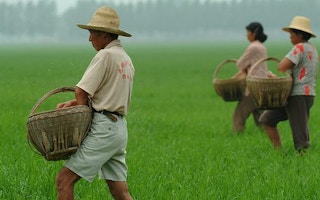Water pollution from agriculture is costing billions of dollars a year in developed countries and is set to rise in China and India as farmers race to increase food production, the Organization for Economic Cooperation and Development said.
“Pollution from farm pesticides and fertilizers is often diffuse, making it hard to pin down exactly where it’s coming from,” Kevin Parris, author of a report by the Paris-based organization, said in an interview in Marseille. “In some big agricultural countries in Europe, like parts of France,Spain and the UK, the situation is deteriorating.”
In some regions of China, pollution of waterways from agriculture may already have reached a level that may cause health problems in humans, he said.
The OECD report is part of a series of studies published this week to coincide with the World Water Forum in Marseille. Ministers, industry representatives and non-government organizations are discussing resource management, waste, health risks and climate change at the meeting. Pollution from farming is gaining prominence as the global population increases, raising demand for food and putting strain on water resources.
Fertilizers such as nitrates and phosphates as well as pesticides that run off farms can contaminate drinking water, harm aquatic life and result in eutrophication, or a proliferation of plants that reduces oxygen content in water and eliminates other sea life, according to the study.
Lakes at risk
“The number of lakes at risk of harmful algal blooms will increase by 20 percent in the first half of this century,” the OECD said. By 2050 the nitrogen surpluses per hectare from agriculture are forecast to drop in OECD member countries and rise in China and India
Costs from agricultural pollution include money spent treating water to remove nitrates, phosphates and pesticide chemicals as well as paying farmers to store manure safely and block contamination from reaching waterways, according to the study. Environmental contamination such as algal blooms also adds to the bill.
Beaches covered in green algae are becoming an annual occurrence in Brittany, France’s westernmost region. The issue pits the region’s 3.6 billion-euro ($4.7 billion) tourism industry against its 8.2 billion-euro farming sector, whose large quantities of animal waste and use of fertilizers are blamed by scientists for feeding the so-called green tides that form in Brittany’s shallow bays.
‘Not going away’
“This is big and it’s not going away,” Parris said, referring to massive blooms in regions around the world including the Gulf of Mexico. “Regulations exist but they are often not enforced.”
In Australia, the cost of algal blooms may be as high as $155 million while the price of eutrophication of surface and coast waters in France could reach as much as $1.4 billion, according to the study. Freshwater eutrophication costs are estimated at $2.2 billion in the US and $2 billion for pesticide contamination of groundwater.
“In China there is already a chronic problem as well as in parts of India,” Parris said. Worldwide researchers aren’t getting the full picture of pollution from farming because access to data is incomplete.
The OECD study also highlights possible health risks from so-called “emerging water contaminants” from agriculture such as veterinary medicines used to treat livestock and substances created from pesticides when they are transformed in the environment.
“The impact of these mixtures is likely to be greater than the impact of the single substance on its own,” the report said.










